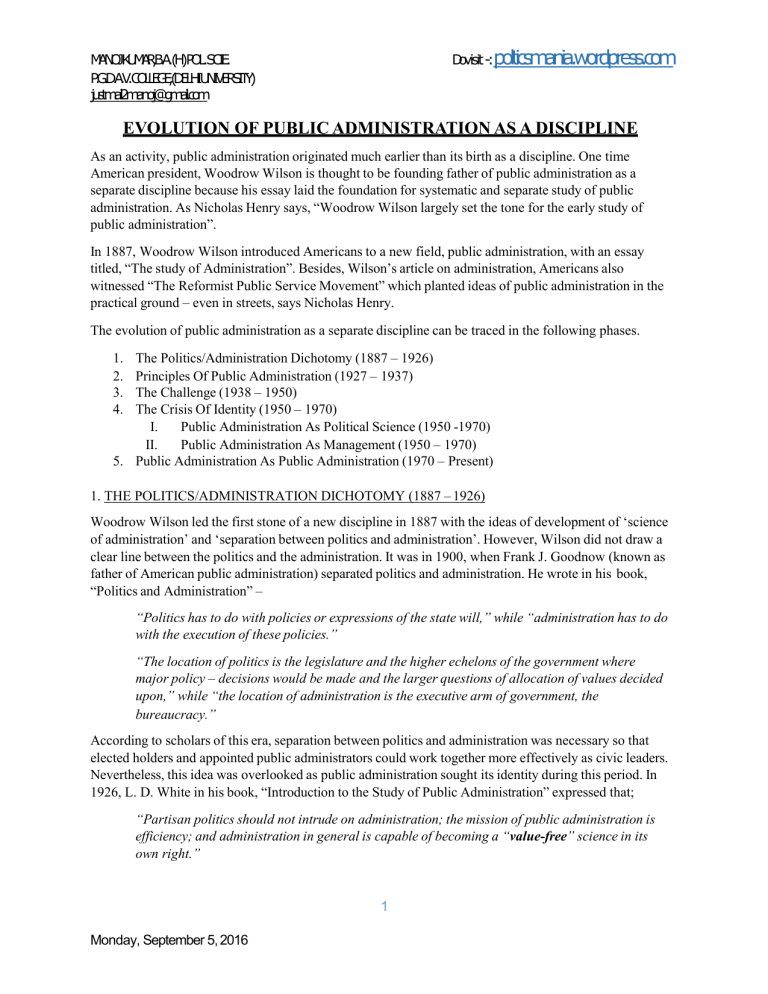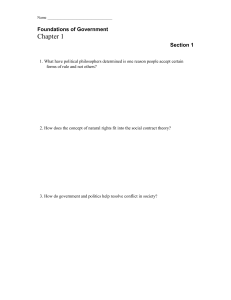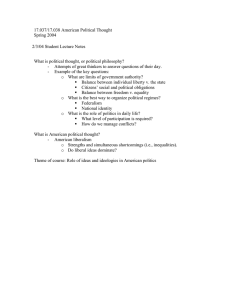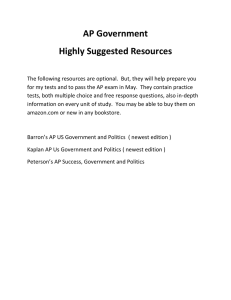
Dovisit -:polticsmania.wordpress.com MANOJKUMAR,B.A.(H)POL.SCIE. P.G.D.A.V.COLLEGE,(DELHIUNIVERSITY) justmail2manoj@gmail.com EVOLUTION OF PUBLIC ADMINISTRATION AS A DISCIPLINE As an activity, public administration originated much earlier than its birth as a discipline. One time American president, Woodrow Wilson is thought to be founding father of public administration as a separate discipline because his essay laid the foundation for systematic and separate study of public administration. As Nicholas Henry says, “Woodrow Wilson largely set the tone for the early study of public administration”. In 1887, Woodrow Wilson introduced Americans to a new field, public administration, with an essay titled, “The study of Administration”. Besides, Wilson’s article on administration, Americans also witnessed “The Reformist Public Service Movement” which planted ideas of public administration in the practical ground – even in streets, says Nicholas Henry. The evolution of public administration as a separate discipline can be traced in the following phases. The Politics/Administration Dichotomy (1887 – 1926) Principles Of Public Administration (1927 – 1937) The Challenge (1938 – 1950) The Crisis Of Identity (1950 – 1970) I. Public Administration As Political Science (1950 -1970) II. Public Administration As Management (1950 – 1970) 5. Public Administration As Public Administration (1970 – Present) 1. 2. 3. 4. 1. THE POLITICS/ADMINISTRATION DICHOTOMY (1887 – 1926) Woodrow Wilson led the first stone of a new discipline in 1887 with the ideas of development of ‘science of administration’ and ‘separation between politics and administration’. However, Wilson did not draw a clear line between the politics and the administration. It was in 1900, when Frank J. Goodnow (known as father of American public administration) separated politics and administration. He wrote in his book, “Politics and Administration” – “Politics has to do with policies or expressions of the state will,” while “administration has to do with the execution of these policies.” “The location of politics is the legislature and the higher echelons of the government where major policy – decisions would be made and the larger questions of allocation of values decided upon,” while “the location of administration is the executive arm of government, the bureaucracy.” According to scholars of this era, separation between politics and administration was necessary so that elected holders and appointed public administrators could work together more effectively as civic leaders. Nevertheless, this idea was overlooked as public administration sought its identity during this period. In 1926, L. D. White in his book, “Introduction to the Study of Public Administration” expressed that; “Partisan politics should not intrude on administration; the mission of public administration is efficiency; and administration in general is capable of becoming a “value-free” science in its own right.” 1 Monday, September 5, 2016 Dovisit -:polticsmania.wordpress.com MANOJKUMAR,B.A.(H)POL.SCIE. P.G.D.A.V.COLLEGE,(DELHIUNIVERSITY) justmail2manoj@gmail.com This perspectives provided an intellectual base for the next phase of public administration which focused on the idea that like principles of science, there were principles of administration. 2. PRINCIPLES OF PUBLIC ADMINISTRATION (1927 – 1937) In 1927, W. F. Willoughby wrote in his book, “The principles of Public Administration” that – “Public administrators would be effective if they learned and applied scientific principles of administration.” This suffused the whole management theory into public administration which proved poison for newly born field, public administration. Mohit Bhattacharya writes – “during this period, focus of public administration from ‘public’ was replaced almost wholly by ‘efficiency’.” Advocates of the principles approach believed in:a. Universality Of administrative principles which could be applied to all sorts of organization anywhere regardless of culture, administrative setting, institutional framework, environment, function, mission etc. b. Principle approach would promote efficiency and economy in administration. However, in 1935, Princeton University hosted a national conference where it was found that public administration could not be established as separate field of study within the universities. 3. THE CHALLENGE (1938-1950) During this phase, both the first and the second phase were challenged. It was objected thata. Politics and administration could never be separated clearly because in practice, there is close nexus between politics and administration. In 1950, a scholar wrote, “A theory of public administration means in our time a theory of politics also.” And hence, Nicholas Henry says, “With this declaration, the dichotomy died.” b. Principles of administration were not something big enough. Herbert Simon and Robert Dahl were in support of the above two objections. In 1947, Herbert Simon in his book, “Administrative Behavior” wrote that – “A fatal defect of the current principles of administration is that for almost every principle one can find an equally plausible and acceptable contradictory principle.” In Simon’s conclusion, principles are unscientifically derived and no more than proverbs. He also rejected separation between politics and administration and argued for ‘logical positivism’ in the study of policymaking and relation of means and ends. He observed that decision-making must be derived from the logic and psychology of human choice. While Robert Dahl in his essay, “The Science of Public Administration” expressed three problems in the evolution of science of public administration – i. ii. iii. Exclusion of normative consideration from public administration. Exclusion of the study of human behavior from the science of public administration. Exclusion of the varying historical, sociological, economic & other conditioning factors from the science of public administration. 2 Monday, September 5, 2016 Dovisit -:polticsmania.wordpress.com MANOJKUMAR,B.A.(H)POL.SCIE. P.G.D.A.V.COLLEGE,(DELHIUNIVERSITY) justmail2manoj@gmail.com By 1950s, both the objections were completely rejected by scholars of public administration. This rejections left public administration without identity, and thus a new phase of evolution of the discipline of public administration took birth. 4. THE CRISIS OF IDENTITY (1950-1970) I. PUBLIC ADMINISTRATION AS POLITICAL SCIENCE (1950-1970) In this phase, public administration was reestablished into the mother discipline, political science. But there were several issues such asa. Absence of comprehensive intellectual framework for public administration as a separate discipline. b. And willing of political scientists to engulf public administration into political science. So observers rightly commented that –“public administration stands in danger of …senescence, and that lusty young giant of a decade ago, may now ‘evaporate’ as a field.” During 1960s, the American Political Science Association moved officially to rid itself of public administration. So, a scholar pointed that political science seems to have less utility in the education of public administrators. Political science educates for “intellectualized understanding” of public administration, whereas public administration educates for “knowledgeable action”. II. PUBLIC ADMINISTRATION AS MANAGEMENT (1950-1970) As public administration was struggling for its identity, a few public administrationists began searching for an alternative. They found it in ‘management’, called either ‘administrative science’ or ‘generic management’ , which holds that sector, culture, institution, mission, so on and so forth have little consequence to efficient and effective administration, and that “a body of knowledge” – statistics, economics, accounting, operation research, and organization are often needed, and exists common to the field of administration. But it is noteworthy that “management’s focus is exclusively technical, whereas public administration’s focus is both technical and normative. Finally, it was becoming increasingly clear to public administrationists that neither political science nor management addressed their interest, nor could they. With this, a new phase began. 5. PUBLIC ADMINISTRATION AS PUBLIC ADMINISTRATION (1970-PRESENT) Public administration as public administration is refers to public administration’s successful break with political science and management, and its emergence as an autonomous field of study and practice. So in 1970, public administration declared as an independent discipline with the birth of National Association of schools of Public Administration (NASPAA). Finally, according to recent research, pioneering of public administration were right on several important counts such as – Professional public administration improves governance, public administrators and politicians work in team to fulfill the public interest, even though elected politicians and appointed administrators do different things, etc. 3 Monday, September 5, 2016 Dovisit -:polticsmania.wordpress.com MANOJKUMAR,B.A.(H)POL.SCIE. P.G.D.A.V.COLLEGE,(DELHIUNIVERSITY) justmail2manoj@gmail.com Public administration happy at last…….. References:1. Nicholas Henry, Public Administration & Public Affairs 2. Mohit Bhattacharya, A New Horizons of Public Administration 3. S. Polynaidu, Public Administration 4 Monday, September 5, 2016




